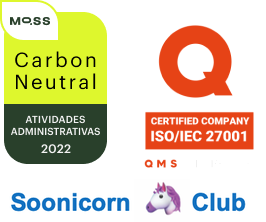What is TMS
Logistics costs are known to be among the biggest expenses a company has as part of its operations.
In addition, transportation is a crucial process to ensure customer satisfaction, as it is the final step of the order cycle and links your business and your consumers. These activities call for efficient management, and that’s precisely where a Transportation Management System, or TMS, comes in.
We’re going to look a little closer at this tool, along with the benefits it provides, its functionalities, and the right time
to invest in one. Read on to find out more!

Understand what a Transportation Management System is, once and for all

The Transportation Management System, or TMS software, is a platform focused on transportation management (as the name suggests) and is usually flexible enough to integrate with an ERP, facilitating the control of a company’s entire logistics flow.
Typically, TMS tracking is divided into modules, purchased according to business need. The aim is to increase quality and productivity in cargo distribution processes. With regard to ERP integration, it facilitates the exchange of financial, accounting and tax information, as well as streamlining the issuance of documents such as eBL and e-Invoice for Services.
TMS Functionalities
Transportation Management System functionalities may vary depending on the developer. However, they range from more operational issues to management support. Including:
This functionality helps to choose the best carrier for each shipment that is made, through freight tables. With this, it becomes possible to reduce transportation costs and offer a more attractive freight rate to your customers.
In addition, there is the flexibility to change the calculation parameters and create restrictions, depending on the type of order, recipient address, carrier, product, customer profile, among other things.
This functionality automates the exchange of information — regarding the dispatch of orders — with carriers and the Post Office, which helps to optimize processes, making them simpler and more agile.
It is also possible to generate labels, pre-lists of posts and packing lists, through integration with the systems that are used. This data exchange can be done through EDI and webservice, for example.
Thismodule allows tracking the status of shipments in real time, in addition to automating the process of notifying customers about deliveries. This helps reduce fulfillment, redelivery, and return costs.
This way, you can closely monitor the status of orders by region, by shipping and delivery date, by carrier, and even analyze occurrences. And this data can still be integrated into other platforms, such as SAC and other systems.
Another possibility of this tracking is the implementation of proactive notifications, which are nothing more than sending updates on the status of orders to customers, even before they contact the call center.
Also called Invoice Reconciliation, this functionality helps in checking the CT-es and the invoices that are issued to contracted carriers and the Post Office. This provides faster analysis, reduces the error rate and simplifies financial management.
With this tool, it is possible to identify divergences in the amounts charged in relation to the freight tables and also in the product registration, or in the operational processes — which can cause errors in the final calculation.
Benefits of using TMS
- 2.1. Automates freight calculations
- 2.2. Streamlines shipment management
- 2.3. Optimizes deliveries through automatic tracking
- 2.4. Permits the generation of pre-invoices
- 2.5. Enables real-time reporting
Using Transportation Management System, various data are crossed automatically, making use of different freight tables from different carriers. The result is obtained in real time and based on the business rules that were configured.
In addition, through data processing (modals, deadlines, freight tables, risk management, among others), it is possible to simulate scenarios and choose the best strategy according to each trip — which guarantees a decision based on cost- benefit.
In this way, your team becomes more productive and directed to more strategic processes, while it is possible to increase agility in decisions and without the risk of errors.
With this module, it becomes possible to integrate the company’s system with carriers and the Post Office, facilitating the generation of documents such as packing lists and postage labels, for example — which speeds up the shipping process.
Thus, activating the carriers is faster, which also promotes a decrease in order lead time. With the delivery time reduced in a structured way, quality increases and customers become more satisfied with the service provided.
The automatic tracking of loads helps to identify occurrences that may jeopardize deliveries. This helps to avoid issues such as redeliveries and returns — which increase logistical costs and make processes inefficient.
In this way, the manager can adopt some improvements in transport, such as:
- • open calls and handle incidents proactively;
- • monitor customer satisfaction with the delivery service (the so-called Net Promoter Score, or NPS);
- • notify customers via SMS or email and keep them updated regarding their orders;
- • notify carriers regarding lack of information and pending issues, for example.
By auditing invoices, validations are carried out in charging freight, in addition to identifying discrepancies between what was agreed and what is being charged by the carrier. If the values are correct, the payment is released.
In cases where the company does not use the pre-invoice, it is possible to use the TMS to read the CT-e and the invoices and carry out the conciliation of amounts, using the freight tables.
The generation of reports provides the manager with more solid knowledge for decision making. With this option, it becomes possible to identify process failures, their causes and create more precise action plans, in addition to pointing out which steps can be improved.
Why use TMS in logistics operations?
- 3.1. More assertive decisions
- 3.2. Delivery route optimization through logistics scheduling
- 3.3. Improving processes by tracking incidents
If your company works with fractional loads spread across several regions, developing an optimized route plan is certainly a challenging task. So, creating an agreement with customers to schedule deliveries permits the adoption ” programmed scheduling” – which allows for loads to be consolidated, accumulating a larger volume for distribution.
This allows your company to store up a larger number of orders, to be shipped on specific days, improving routing and optimizing vehicle space – which helps to reduce operating costs.
However, care must be taken not to leave orders waiting too long to be loaded, which adversely impacts lead time.
To this end, TMS software helps to control these issues, considering the delivery time, the shipping date and the scheduling date. Thus, transportation can be triggered at the most appropriate time, informing the carrier when the loads can be picked up and dispatched.
There’s a saying in the management industry that goes: “You can’t manage what you can’t measure”. In other words, if you can’t track and measure your processes properly, the chances of not achieving the expected results and making an effective and agile decision are greatly reduced.
So, the more information you have about operations, especially deliveries, the greater the chances of being able to anticipate risks and implement more assertive actions.
In the case of proactive notifications (mentioned above), for example, TMS helps to improve incident management, providing the manager with real-time information, identifying problems and notifying the customer immediately.
While this strategy doesn’t prevent dissatisfaction altogether, it does help to balance expectations and make sure consumers aren’t caught off guard, making the process transparent and your company more trustworthy.
This option helps reduce customer support workloads – since customers do not need to contact you to follow up on their deliveries – and allow this team to focus on solving more important issues.
With the help of TMS, your company can transform management, shifting from being reactive (putting out fires) and allowing the manager to anticipate risks and avoid them, or minimize their impacts.
When is it time to deploy a Transportation Management System?
Besides the benefits mentioned earlier, there are several other reasons why TMS software is indispensable for logistics operations. Some of them include:
- 4.1. Slow and unstructured processes
- 4.2. Decentralized information with inefficient control
- 4.3. Waste
- 4.4. Difficulty in decision making
Have you noticed that your processes do not have an execution pattern and that this makes them take longer to run? In addition, have you noticed that there is a higher occurrence of errors and rework than is desirable?
These are some of the points that affect your management and make it difficult to evaluate results fairly, or even train new employees.
TMS helps to solve this problem as it requires the standardization of working methods, in addition to the standardization of data entry into the system. In this way, activities are more organized and less subject to failures.
If you use several spreadsheets and controls to monitor processes, causing information to be spread out, it is a sign that it is time to invest in technology.
These flaws make finding data and sharing it more time consuming and complex. In addition, the analysis and decision-making processes are also impaired, as the consolidation of information is also more complicated.
Waste represents a major problem for companies, as well as generating financial losses, since there is no efficiency and money is spent inappropriately. Among the main ones, we can mention:
- • of materials;
- • of machinery and equipment;
- • of labor;
- • of time;
- • vehicle idleness;
- • improper loading.
This problem is related to the lack of centralization of information. If creating controls is already a difficult task, imagine making strategic decisions, relevant to the definition of new action plans.
Therefore, if you do not feel that you have a reliable database, it is a sign that it is time to hire a TMS solution.
In addition to these issues that have already been mentioned, there are other aspects — which are not always noticed — that also indicate that it may be time to invest in technology, such as:
- • recurring delays in deliveries;
- • high rate of damages and losses;
- • difficulties in cargo traceability;
- • unauthorized charges;
- • difficulty in drawing up performance indicators.
If you’ve noticed that your pains are linked to the aspects we’ve listed above, it’s time to consider implementing TMS to improve control over activities and make them more efficient.
How to obtain TMS software
- 5.1. Assess whether the system can meet your business needs
- 5.2. Assess what functionalities are offered
- 5.3. Check for flexibility
- 5.4. Check whether the TMS ensures scalability
- 5.5. Assess how the TMS software provider offers support
- 5.6. Research the developer
- 5.7. Assess the cost-benefit ratio
The first step entails a thorough diagnosis of your company, along with an analysis of necessities and how a TMS software can meet them. That is, make a list of all the problems that need to be solved and the reasons that led you to make this decision.
From that point, a more assertive search begins for Transportation Management System solutions that suit your business, with the one that best meets these requirements like to be the final choice.
During your search for a TMS solution, you are likely to come across several offers, with the most varied functionalities. This is where anticipated planning comes in: allowing you to check which are really necessary and which can be dispensed with – which would lead to unnecessary spending.
It is not uncommon for certain investments to fail on delivering expected return because companies try to adapt to the system, while it is the software that needs to adapt to their processes. This is why it is important to assess your needs and the characteristics of the tool before hiring it.
Although logistics processes are very similar in companies, each one has particularities that need to be understood and addressed. This makes it necessary to assess whether the system you intend to purchase offers flexibility.
This calls for a degree of customization – to fit the processes – and this is only possible when the TMS is flexible. If the solution purchased is more concrete and limited, the chances of an inefficient system are very high.
As such, before investing in a Transportation Management System, map the processes and design the flow of activities. This helps to understand how they are run, what flaws need to be corrected and helps identify opportunities for improvement. Once all changes have been applied, working methods are standardized.
Thus, in addition to optimizing routines, you can hire a more suitable solution.
One of the main goals of any manager is to promote business growth. To avoid unnecessary costs in the future, you need a scalable Transportation Management System. That is, it has the capacity to support the increased volume of data and processes.
Therefore, it is worth checking whether the TMS in question ia able to increase the database and continue to offer quality management support. This is critical so that your investment is not wasted in the long run.
Another point that should be evaluated when hiring a TMS is whether the developer offers user support. Whenever a new solution is adopted, employees need some time to get used to the change, not to mention the time needed to absorb learning.
If the company fails to provide support that goes beyond system use training, these issues can become even more complicated – since after implementation doubts and other operational problems may arise.
Price is one of the most influential factors when deciding whether to hire a service. However, it should never be the only one.
Considerations must include the quality and type of service, and support, among other aspects.
Furthermore, many managers still see the adoption of a system as an extra company expense. However, with all the benefits that this solution provides, it is safe to say that the cost-benefit ratio is satisfactory – especially if we consider that, with the cost reduction, the investment is paid back after a certain time.
